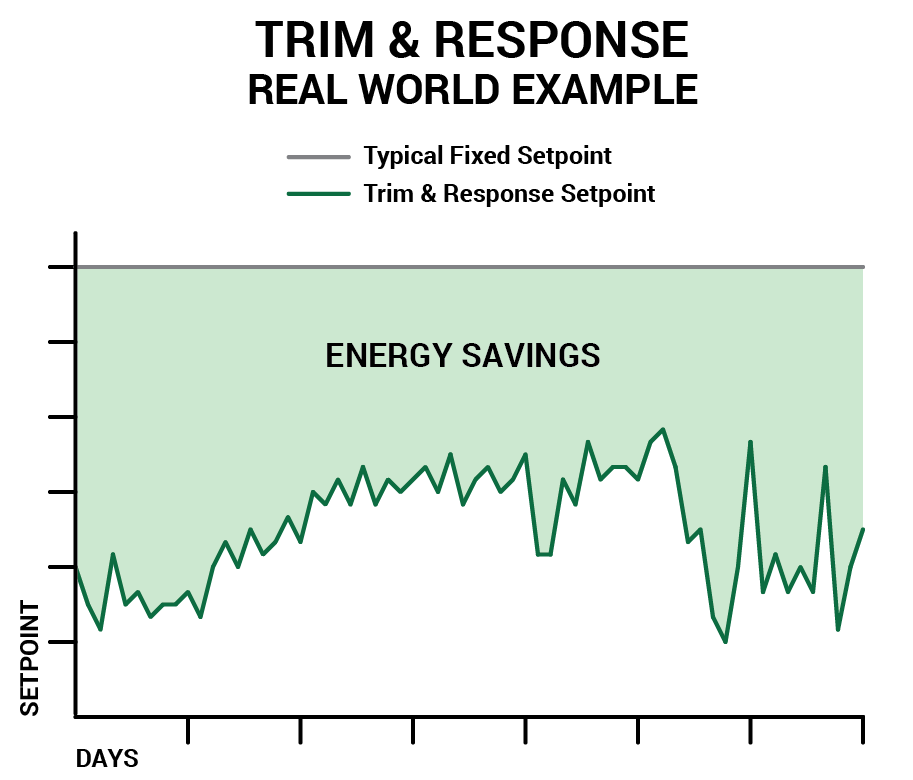HVAC System Trim & Response Resets
When a building is newly constructed, one of the last steps performed on the HVAC system is the testing, adjusting, and balancing (TAB). The purpose of TAB is to verify the design air and water flows are properly supplied throughout the building. One of the most critical components of the process is to determine the appropriate control setpoints for these systems. In a variable-air volume (VAV) air handling system, this is typically the static pressure setpoint. To determine the setpoint, the TAB contractor will first set all the VAV boxes to their maximum cooling airflow setpoint. The static pressure of the ductwork is then gradually increased until all boxes can satisfy their airflow requirements. This static pressure will then be the control setpoint for the air handling unit’s supply fan. The fan will modulate speed to maintain this pressure continuously. Similarly, on a hydronic pumping system, the TAB contractor will provide a differential pressure setpoint based on system flow requirements so that the pumps will modulate speed to maintain the flow rates needed.
However, there is a flaw with this process. These setpoints are for the maximum design load condition, and these pressures are only required during the peak of the cooling or heating season. Throughout the rest of the year, the system will operate at much lower load conditions that require less energy. Using a “trim & response” control algorithm, a building automation system can continuously optimize the control setpoints based on the actual demand of the system. Whether a duct static pressure setpoint or a differential pressure setpoint will be reset, the process remains the same.
For an air distribution system, VAV damper commands are polled. If all VAV dampers are partially closed, it can be determined that the associated airflow requirements are all satisfied. As a result, the duct static pressure setpoint would be incrementally decreased, resulting in a reduction in fan speed. The VAV system is then continuously polled and the setpoint is reset downwards until any VAV damper opens beyond the predefined setpoint (typically 90% damper command). In this case, the VAV requires more airflow to satisfy its setpoint. As a result, the duct static pressure setpoint will begin to reset upwards.
The process is similar for hydronic distribution systems. The associated control valve commands are polled. If all control valves are partially closed, it can be determined that the associated heating or cooling load requirements are satisfied. As a result, the system differential pressure setpoint would be incrementally decreased resulting in a reduction in pump speed. The coil valves are then continuously polled and the setpoint is reset downwards until any control valve opens beyond the predefined setpoint (typically 90% valve position). In this case, the associated coil may require more flow to satisfy its setpoint. As a result, the differential pressure setpoint will begin to reset upwards.
Although hydronic and airside systems are very different, a setpoint reset can be achieved using the exact same process. By implementing a trim and response logic, the system is constantly assessed and the control setpoint reset accordingly.
 The energy savings associated with the trim & response resets come from allowing the fan and pump motors to operate at lower speeds during low load conditions. As a real-world example, let’s look at a typical rooftop unit that serves a VAV system. Without a reset, this system modulates the supply fan speed to maintain a static pressure setpoint of 1.5” W.C. year-round. However, with a reset programmed the static pressure setpoint is allowed to reset downwards to 0.5” W.C. during low load conditions when all VAV boxes are at minimum airflow setpoint. For a rooftop unit with a 20 HP supply fan motor, a static pressure reset would be able to save approximately 2,000 kWh a year of energy. At an average wrapped energy cost of $0.13/kWh, this results in about $260/year in energy savings. In a facility that might have 10 to 15 rooftop units, the savings become quite significant.
The energy savings associated with the trim & response resets come from allowing the fan and pump motors to operate at lower speeds during low load conditions. As a real-world example, let’s look at a typical rooftop unit that serves a VAV system. Without a reset, this system modulates the supply fan speed to maintain a static pressure setpoint of 1.5” W.C. year-round. However, with a reset programmed the static pressure setpoint is allowed to reset downwards to 0.5” W.C. during low load conditions when all VAV boxes are at minimum airflow setpoint. For a rooftop unit with a 20 HP supply fan motor, a static pressure reset would be able to save approximately 2,000 kWh a year of energy. At an average wrapped energy cost of $0.13/kWh, this results in about $260/year in energy savings. In a facility that might have 10 to 15 rooftop units, the savings become quite significant.
A smoothly operating reset will ensure the correct setpoint is being controlled at all times, however, care must be taken to ensure proper maintenance is performed when using this type of reset. If any VAV damper or valve is broken or not properly controlling, it can drive the reset setpoint to its maximum value. Exercising good maintenance practices and fault, detection & diagnostic programming, problematic valves and dampers can be quickly identified and addressed to ensure the reset will operate for years to come.
This strategy can be combined with many other strategies that we have already discussed or will review in upcoming articles in this retro-commissioning series. Take a look at our other ECM tips here. If you have any questions about this article or think you might be able to apply this strategy in your facility and would like to learn more, please contact us here.

About the Author:
Brian Messerschmidt is a Project Manager at Sustainable Engineering Solutions. He has managed numerous Commissioning and Retro-Commissioning projects throughout Connecticut and Massachusetts. Brian earned his B.S. in Mechanical Engineering from Central Connecticut State University. He is a registered Professional Engineer in the State of Connecticut and a Certified Energy Manager.
